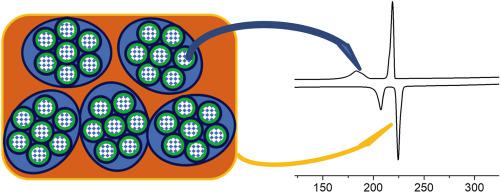当前位置:
X-MOL 学术
›
Sol. Energy Mater. Sol. Cells
›
论文详情
Our official English website, www.x-mol.net, welcomes your feedback! (Note: you will need to create a separate account there.)
Shape-stabilized phase change materials using molten NaNO3 – KNO3 eutectic and mesoporous silica matrices
Solar Energy Materials and Solar Cells ( IF 6.9 ) Pub Date : 2020-09-01 , DOI: 10.1016/j.solmat.2020.110644 Raul-Augustin Mitran , Daniel Lincu , Lucian Buhǎlţeanu , Daniela Berger , Cristian Matei
Solar Energy Materials and Solar Cells ( IF 6.9 ) Pub Date : 2020-09-01 , DOI: 10.1016/j.solmat.2020.110644 Raul-Augustin Mitran , Daniel Lincu , Lucian Buhǎlţeanu , Daniela Berger , Cristian Matei

|
Abstract Storing energy as heat at temperatures above 200 °C is necessary for both efficient industrial processes and continuous solar energy generation. In this study composite shape-stabilized phase change materials were obtained using mesoporous silica as matrix and the NaNO3 – KNO3 eutectic mixture as the active heat storage component. Five types of mesoporous matrices, including hexagonal MCM-41 and SBA-15, cubic FDU-12 and two mesocellular foam silica were investigated. With the exception of MCM-41, all mesoporous matrices yielded shape-stabilized phase change materials with thermal stability above 500 °C and two melting and two crystallization events, indicating the presence of both nanoconfined and interparticle molten salts phases. The materials do not present significant enthalpy change over 50 heating – cooling cycles. The composites containing 80% wt. nitrate eutectic exhibit total heat of fusion of 69–84 Jg-1, representing ~79–96% of the theoretical values. The melting point depressions of the nanoconfined phase and “missing” heat of fusion are evidence for the presence of a non-melting, layer at the silica - nitrate interface, having a thickness of 1.9 nm. A theoretical model of the non-melting layer was used to compare the salt distribution between the layer and nanoconfined phase with experimental data. FDU-12 and mesocellular foam silica were found suitable matrices for NaNO3–KNO3 molten salts, which could be used to tailor the heat storage distribution and temperature range.
中文翻译:

使用熔融 NaNO3 – KNO3 共晶和介孔二氧化硅基质的形状稳定相变材料
摘要 在高于 200 °C 的温度下将能量储存为热量对于高效的工业过程和连续太阳能发电都是必要的。在本研究中,以介孔二氧化硅为基体,以 NaNO3-KNO3 共晶混合物为活性蓄热组分,获得了复合形状稳定相变材料。研究了五种类型的介孔基质,包括六方 MCM-41 和 SBA-15、立方 FDU-12 和两种介孔泡沫二氧化硅。除 MCM-41 外,所有介孔基质均产生形状稳定的相变材料,其热稳定性高于 500 °C,并且具有两次熔化和两次结晶事件,表明存在纳米限制和粒子间熔盐相。这些材料在 50 次加热-冷却循环中没有显着的焓变。含有 80% wt 的复合材料。硝酸盐共晶的总熔化热为 69-84 Jg-1,相当于理论值的 79-96%。纳米限制相的熔点降低和“缺失”熔化热证明在二氧化硅 - 硝酸盐界面存在非熔化层,厚度为 1.9 nm。非熔融层的理论模型用于将层和纳米限制相之间的盐分布与实验数据进行比较。FDU-12 和中孔泡沫二氧化硅被发现是 NaNO3-KNO3 熔盐的合适基质,可用于定制储热分布和温度范围。纳米限制相的熔点降低和“缺失”熔化热证明在二氧化硅 - 硝酸盐界面存在非熔化层,厚度为 1.9 nm。非熔融层的理论模型用于将层和纳米限制相之间的盐分布与实验数据进行比较。FDU-12 和中孔泡沫二氧化硅被发现是 NaNO3-KNO3 熔盐的合适基质,可用于定制储热分布和温度范围。纳米限制相的熔点降低和“缺失”熔化热证明在二氧化硅 - 硝酸盐界面存在非熔化层,厚度为 1.9 nm。非熔融层的理论模型用于将层和纳米限制相之间的盐分布与实验数据进行比较。FDU-12 和中孔泡沫二氧化硅被发现是 NaNO3-KNO3 熔盐的合适基质,可用于定制储热分布和温度范围。
更新日期:2020-09-01
中文翻译:

使用熔融 NaNO3 – KNO3 共晶和介孔二氧化硅基质的形状稳定相变材料
摘要 在高于 200 °C 的温度下将能量储存为热量对于高效的工业过程和连续太阳能发电都是必要的。在本研究中,以介孔二氧化硅为基体,以 NaNO3-KNO3 共晶混合物为活性蓄热组分,获得了复合形状稳定相变材料。研究了五种类型的介孔基质,包括六方 MCM-41 和 SBA-15、立方 FDU-12 和两种介孔泡沫二氧化硅。除 MCM-41 外,所有介孔基质均产生形状稳定的相变材料,其热稳定性高于 500 °C,并且具有两次熔化和两次结晶事件,表明存在纳米限制和粒子间熔盐相。这些材料在 50 次加热-冷却循环中没有显着的焓变。含有 80% wt 的复合材料。硝酸盐共晶的总熔化热为 69-84 Jg-1,相当于理论值的 79-96%。纳米限制相的熔点降低和“缺失”熔化热证明在二氧化硅 - 硝酸盐界面存在非熔化层,厚度为 1.9 nm。非熔融层的理论模型用于将层和纳米限制相之间的盐分布与实验数据进行比较。FDU-12 和中孔泡沫二氧化硅被发现是 NaNO3-KNO3 熔盐的合适基质,可用于定制储热分布和温度范围。纳米限制相的熔点降低和“缺失”熔化热证明在二氧化硅 - 硝酸盐界面存在非熔化层,厚度为 1.9 nm。非熔融层的理论模型用于将层和纳米限制相之间的盐分布与实验数据进行比较。FDU-12 和中孔泡沫二氧化硅被发现是 NaNO3-KNO3 熔盐的合适基质,可用于定制储热分布和温度范围。纳米限制相的熔点降低和“缺失”熔化热证明在二氧化硅 - 硝酸盐界面存在非熔化层,厚度为 1.9 nm。非熔融层的理论模型用于将层和纳米限制相之间的盐分布与实验数据进行比较。FDU-12 和中孔泡沫二氧化硅被发现是 NaNO3-KNO3 熔盐的合适基质,可用于定制储热分布和温度范围。



























 京公网安备 11010802027423号
京公网安备 11010802027423号